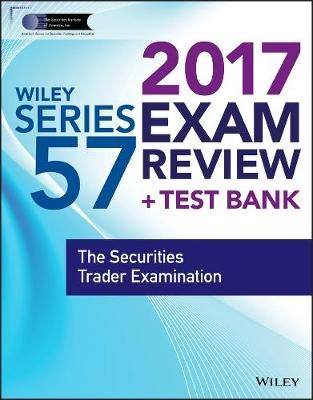
Wiley FINRA Series 57 Exam Review 2017
John Wiley & Sons Inc (Verlag)
978-1-119-37981-2 (ISBN)
- Titel erscheint in neuer Auflage
- Artikel merken
The go-to guide to acing the Series 57 Exam! Passing The Securities Trader Examination (Series 57) qualifies an individual to engage in NASDAQ and OTC Equity trading and to act as a proprietary trader. The exam covers Market Overview and Products, Engaging in Professional Conduct and Adhering to Regulatory Requirements, Trading Activities, Maintaining Books and Records and Trade Reporting. There are no prerequisites to taking the series 57 exam other than being sponsored by a FINRA member firm. Created by the experts at The Securities Institute of America, Inc., Wiley Series 57 Exam Review 2017 arms you with everything you need to pass this challenging 125-question test. Designed to help you build and fine-tune your knowledge of all areas covered in the exam and to guarantee that you're prepared mentally and strategically to take the test, it provides: * Dozens of examples * Assorted practice questions for each subject area covered in the exam * Priceless test-taking tips and strategies * Helpful hints on how to study for the test, manage stress, and stay focused Wiley Series 57 Exam Review 2017 is your ticket to passing the Series 57 test on the first try with flying colors!
Visit www.efficientlearning.com/finra for more information. The Securities Institute of America, Inc. helps thousands of securities and insurance professionals build successful careers in the financial services industry every year. Our securities training options include: * Onsite classes * Private tutoring * Classroom training * Interactive online video training classes * State-of-the-art exam preparation software * Printed textbooks * Real-time tracking and reporting for managers and training directors As a result, you can choose a securities training solution that matches your skill level, learning style, and schedule. Regardless of the format you choose, you can be sure that our securities training courses are relevant, tested, and designed to help you succeed. It is the experience of our instructors and the quality of our materials that make our courses requested by name at some of the largest financial services firms in the world. To contact The Securities Institute of America, visit us on the web at www.SecuritiesCE.com or call 877-218-1776.
About the Series 57 Exam xxi About This Book xxv About the Test Bank xxvii About the Securities Institute of America xxix Chapter 1 Equity Securities 1 What Is a Security? 1 Equity = Stock 2 Common Stock 2 Corporate Time Line 2 Values of Common Stock 4 Book Value 4 Par Value 5 Rights of Common Stockholders 5 Preemptive Rights 5 Characteristics of a Rights Offering 6 Determining the Value of a Right Cum Rights 7 Determining the Value of a Right Ex Rights 7 Voting 8 Limited Liability 9 Freely Transferable 9 The Transfer Agent 10 The Registrar 10 CUSIP Numbers 11 Inspection of Books and Records 11 Residual Claim to Assets 11 Why Do People Buy Common Stock? 11 Income 11 What Are the Risks of Owning Common Stock? 12 How Does Someone Become a Stockholder? 13 Preferred Stock 14 Features of All Preferred Stock 14 Types of Preferred Stock 16 Callable Preferred 17 Types of Dividends 17 Dividend Distribution 18 Taxation of Dividends 20 Selling Dividends 20 Dividend Disbursement Process 21 Warrants 21 How Do People Get Warrants? 21 American Depositary Receipts (ADRs)/American Depositary Shares (ADSs) 22 Currency Risks 23 Functions of the Custodian Bank Issuing ADRs 23 Real Estate Investment Trusts/REITs 23 Non-Traded REITs 24 Direct Participation Programs and Limited Partnerships 24 Limited Partnerships 24 Tax Reporting for Direct Participation Programs 28 Limited Partnership Analysis 28 Tax Deductions vs. Tax Credits 29 Other Tax Considerations 29 Dissolving a Partnership 30 Pretest 31 Chapter 2 Debt Securities 35 Corporate Bonds 35 Types of Bond Issuance 36 Bond Certificate 37 Bond Pricing 37 Corporate Bond Pricing 38 Bond Yields 38 Yield Spreads 42 The Real Interest Rate 43 Bond Maturities 43 Types of Corporate Bonds 44 Converting Bonds into Common Stock 47 Advantages of Issuing Convertible Bonds 48 Disadvantages of Issuing Convertible Bonds 48 Convertible Bonds and Stock Splits 48 Reverse Convertible Securities 48 Forced Conversion 49 The Trust Indenture Act of 1939 49 Bond Indenture 49 Ratings Considerations 50 Retiring Corporate Bonds 50 Collateralized Mortgage Obligation (CMO) 52 CMOs and Interest Rates 53 Types of CMOs 53 Private-Label CMOs 55 Exchange-Traded Notes (ETNs) 55 Euro and Yankee Bonds 56 Pretest 57 Chapter 3 Government Securities 61 Series EE Bonds 61 Series HH Bonds 62 Treasury Bills, Notes, and Bonds 62 Treasury Bond and Note Pricing 63 Treasury Strips 64 Treasury Receipts 64 Treasury Inflation-Protected Securities (TIPS) 65 Agency Issues 65 Government National Mortgage Association (GNMA) 65 Federal National Mortgage Association (FNMA) 66 Federal Home Loan Mortgage Corporation (FHLMC) 66 Federal Farm Credit System (FFCS) 66 Sallie Mae 67 Pretest 69 Chapter 4 The Money Market 71 Money Market Instruments 71 Corporate Money Market Instruments 71 Government Money Market Instruments 73 Municipal Money Market Instruments 74 International Money Market Instruments 74 Interest Rates 74 Pretest 77 Chapter 5 Economic Fundamentals 79 Gross Domestic Product (GDP) 79 Recession 81 Depression 81 Economic Indicators 81 Schools of Economic Thought 83 Economic Policy 84 Tools of The Federal Reserve Board 84 Fiscal Policy 87 Consumer Price Index (CPI) 88 Inflation/Deflation 88 Real GDP 88 International Monetary Considerations 89 Yield Curve Analysis 89 Pretest 91 Chapter 6 Customer Accounts 95 Holding Securities 97 Mailing Instructions 98 Types of Accounts 99 Commingling Customer s Pledged Securities 109 Wrap Accounts 110 Regulation S-P 110 Day Trading Accounts 111 Pretest 113 Chapter 7 Variable Annuities and Retirement Plans 117 Annuities 117 Bonus Annuity 119 Equity-Indexed Annuity 120 Recommending Variable annuities 121 Annuity Purchase Options 122 Accumulation Units 123 Annuity Units 123 Annuity Payout Options 124 Factors Affecting the Size of the Annuity Payment 125 The Assumed Interest Rate (AIR) 125 Taxation 126 Types of Withdrawals 126 Annuitizing the Contract 127 Sales Charges 127 Investment Management Fees 127 Variable Annuity vs. Mutual Fund 127 Retirement Plans 128 Individual Plans 128 Individual Retirement Accounts (IRAs) 128 Corporate Plans 137 Types of Plans 138 Rolling Over a Pension Plan 140 Employee Stock Options 140 Employee Retirement Income Security Act of 1974 (ERISA) 141 ERISA 404C Safe Harbor 142 The Department of Labor Fiduciary Rules 143 Life Insurance 143 Tax Implications of Life Insurance 146 Health Savings Accounts 146 Pretest 149 Chapter 8 Margin Accounts 153 Regulation of Credit 153 Regulation T 153 House Rules 156 Establishing a Long Position in a Margin Account 156 An Increase in the Long Market Value 157 Special Memorandum Account (SMA) Long Margin Account 159 A Decrease in the Long Market Value 161 Minimum Equity Requirement Long Margin Accounts 161 Establishing a Short Position in a Margin Account 162 A Decrease in the Short Market Value 163 Special Memorandum Account (SMA) Short Margin Account 164 An Increase in the Short Market Value 165 Minimum Equity Requirement Short Margin Accounts 166 Combined Margin Accounts 167 Portfolio Margin Accounts 167 Securities Backed Lines of Credit 168 Minimum Margin for Leveraged ETFs 168 Pretest 169 Chapter 9 Mutual Funds 173 Investment Company Philosophy 173 Types of Investment Companies 174 Open-End vs. Closed-End Funds 175 Diversified vs. Nondiversified 176 Investment Company Registration 177 Investment Company Components 179 Mutual Fund Distribution 181 Selling Group Member 181 Distribution of No-Load Mutual Fund Shares 182 Distribution of Mutual Fund Shares 182 Mutual Fund Prospectus 182 Characteristics of Open-End Mutual Fund Shares 184 Mutual Fund Investment Objectives 185 Other Types of Funds 186 Alternative Funds 187 Floating Rate Bank Loan Funds 187 Bond Funds 187 Valuing Mutual Fund Shares 189 Changes in the NAV 190 Sales Charges 191 12B-1 Fees 193 Calculating a Mutual Fund s Sales Charge Percentage 194 Finding the Public Offering Price 194 Sales Charge Reductions 195 Breakpoint Schedule 195 Letter of Intent 196 Backdating a Letter of Intent 196 Breakpoint Sales 196 Rights of Accumulation 197 Automatic Reinvestment of Distributions 197 Other Mutual Fund Features 198 Cost Base of Multiple Purchases 202 Purchasing Mutual Fund Shares 203 Sales Charges 205 45-Day Free Look 206 Withdrawal Plans 206 Recommending Mutual Funds 207 Structured Retail Products/SRPs 208 Pretest 209 Chapter 10 Issuing Corporate Securities 215 The Prospectus 216 The Final Prospectus 217 Providing the Prospectus to Aftermarket Purchasers 218 SEC Disclaimer 218 Misrepresentations 219 Tombstone Ads 219 Free Riding and Withholding/FINRA Rule 5130 220 Underwriting Corporate Securities 221 Types of Underwriting Commitments 222 Types of Offerings 224 Awarding the Issue 225 The Underwriting Syndicate 225 Selling Group 225 Underwriter s Compensation 226 Underwriting Spread 227 Factors That Determine the Size of the Underwriting Spread 227 Review of Underwriting Agreements by FINRA 227 Underwriter s Compensation 228 Unreasonable Compensation 228 Offering of Securities by FINRA Members 230 Exempt Securities 230 Exempt Transactions 231 Crowdfunding 237 Rule 137 Nonparticipants 239 Rule 138 Nonequivalent Securities 240 Rule 139 Issuing Research Reports 240 Rule 415 Shelf Registration 241 Securities Offering Reform Rules 241 SEC Rule 405 242 Additional Communication Rules 243 DPP Roll-UP Transactions 244 Pretest 245 Chapter 11 Brokerage Office Procedure 249 Executing an Order 249 Customer Confirmations 251 Clearly Erroneous Reports 252 Execution Errors 252 Corporate and Municipal Securities Settlement Options 252 RVP/DVP/COD 253 When-Issued Securities 253 Government Securities Settlement Options 254 Accrued Interest 254 Calculating Accrued interest 255 Accrued Interest for Government Notes and Bonds 256 Rules for Good Delivery 257 Delivery of Round Lots 258 Delivery of Bond Certificates 258 Rejection of Delivery 259 Don t Know (DK) Procedures 259 Fail to Deliver/Fail to Receive 259 Due Bills 259 Customer Account Statements 260 Carrying of Customer Accounts 260 Proxies 261 Pretest 263 Chapter 12 Trading Securities 269 Types of Orders 269 The Exchanges 273 Priority of Exchange Orders 274 The Role of the Designated Market Maker 274 Crossing Stock 277 Do Not Reduce (DNR) 277 Adjustments for Stock Splits 278 Stopping Stock 279 Commission House Broker 280 Two-Dollar Broker 280 Registered Traders 280 Super Display Book (SDBK) 280 Short Sales 281 Affirmative Determination 281 Regulation SHO 282 Rule 200 Definitions and Order Marking 282 Rule 203 Security Borrowing and Delivery Requirements 283 Threshold Securities 284 Block Trades 285 Trading Along 286 Circuit Breakers 286 Limit Up Limit Down (Luld ) 287 Listing Requirements for the NYSE 287 Reading the Consolidated Tape 288 Exchange Qualifiers 290 Over-the-Counter/Nasdaq 290 High Frequency and Algorithmic Trading 301 Market Centers 303 SEC Regulation NMS 304 SEC Regulation ATS 305 Direct Market Access 305 Nasdaq International 307 Non-Nasdaq OTCBB 307 Pink OTC Market 308 Third Market 308 Nasdaq Market Center for Listed Securities 309 Fourth Market 309 Nasdaq Listing Standards 309 Market Maker Regulations and Responsibilities 310 Times for Entering a Quote 310 Withdrawing Quotes 313 Handling and Displaying Customer Limit Orders 314 The Order Audit Trail System (OATS) 316 The Manning Rule 317 Automated Confirmation System (ACT)/Trade Reporting Facility (TRF) 317 ACT Trade Scan 318 Nasdaq Trade Reporting Facility (TRF) 319 Step Out Trades 322 Market Making During Syndication 323 Regulation M, Rule 101 323 Penalty Bids 324 Regulation M, Rule 102 324 Regulation M, Rule 103 324 Passive Market Makers Daily Purchase Limit 325 Regulation M, Rule 104 325 Syndicate Short Positions 327 Regulation M, Rule 105 327 Trade Reporting and Compliance Engine (TRACE) 327 Broker vs. Dealer 330 FINRA 5 Percent Markup Policy 330 Markups/Markdowns When Acting as a Principal 331 Riskless Principal Transactions 332 Proceeds Transactions 333 Dominated and Controlled Markets 333 Net Transactions with Customers 334 Firm Quote Rule 334 The Firm Quote Compliance System (Fqcs ) 335 Trade Complaints Between Members 335 Rogue Trading Prevention 336 Arbitrage 336 Pretest 339 Chapter 13 Options 345 Option Classification 345 Option Classes 346 Option Series 346 Bullish vs. Bearish 346 Possible Outcomes for an Option 347 Characteristics of All Options 348 Managing an Option Position 348 Buying Calls 349 Selling Calls 350 Buying Puts 352 Selling Puts 353 Option Premiums 355 At the Money Options 355 Out of the Money Options 356 Intrinsic Value and Time Value 356 Using Options as a Hedge 357 Long Stock Long Puts/Married Puts 357 Long Stock Short Calls/Covered Calls 359 Maximum Gain Long Stock Short Calls 360 Maximum Loss Long Stock Short Calls 361 Short Stock Long Calls 361 Maximum Gain Short Stock Long Calls 362 Maximum Loss Short Stock Long Call 363 Short Stock Short Puts 363 Maximum Gain Short Stock Short Puts 364 Maximum Loss Short Stock Short Puts 365 Multiple Option Positions and Strategies 366 Long Straddles 366 Short Straddles 368 Spreads 370 Combinations 381 Using a T Chart to Evaluate Option Positions 382 Index Options 386 Interest Rate Options 388 Price-Based Options 388 Rate-Based Options 390 Foreign Currency Options 390 The Option Clearing Corporation 392 The Options Markets 393 The Chicago Board Option Exchange 393 Opening and Closing Option Prices 395 Order Execution 395 Expiration and Exercise 396 American vs. European Exercise 396 Market Volatility Options/VIX 397 Flex Options 397 Weekly Options 398 Mini Options 398 Position and Exercise Limits 399 Stock Splits and Stock Dividends 399 Taxation of Options 400 Closing an Option Position 400 Exercising a Call 400 Exercising a Put 401 Protective Puts 401 Covered Calls 401 Option Compliance 401 Option Agreement 401 Pretest 403 Chapter 14 Securities Industry Rules and Regulations 411 The Securities Exchange Act of 1934 411 The Securities and Exchange Commission (SEC) 412 Extension of Credit 413 The National Association of Securities Dealers (NASD) 413 Becoming a Member of FINRA 415 Hiring New Employees 416 Disciplinary Actions Against a Registered Representative 417 Resignation of a Registered Representative 418 Continuing Education 418 Termination for Cause 420 Retiring Representatives/Continuing Commissions 420 State Registration 420 Registration Exemptions 421 Persons Ineligible to Register 421 Communications with the Public 421 FINRA Rule 2210 Communications with the Public 422 Broker Dealer Websites 425 Blind Recruiting Ads 426 Generic Advertising 426 Tombstone Ads 426 Testimonials 427 Free Services 427 Misleading Communication with the Public 428 Securities Investor Protection Corporation Act of 1970 428 Net Capital Requirement 428 Customer Coverage 429 Fidelity Bond 429 The Securities Acts Amendments of 1975 429 The Insider Trading & Securities Fraud Enforcement Act of 1988 430 Firewall 430 Telemarketing Rules 431 Do Not Call List Exemptions 432 The Penny Stock Cold Call Rule 432 The Role of the Principal 433 Violations and Complaints 433 Resolution of Allegations 433 Minor Rule Violation 434 Code of Arbitration 434 The Arbitration Process 435 Mediation 436 Currency Transactions 437 The Patriot Act 437 U.S. Accounts 439 Foreign Accounts 439 Annual Compliance Review 439 Business Continuity Plan 439 Sarbanes-Oxley Act 440 The Uniform Securities Act 441 Tender Offers 442 Stockholders Owning 5% of an Issuer s Equity Securities 443 Pretest 445 Answer Keys 451 Appendix 467 Glossary of Exam Terms 501 Index 567
| Erscheinungsdatum | 02.04.2017 |
|---|---|
| Verlagsort | New York |
| Sprache | englisch |
| Maße | 215 x 277 mm |
| Gewicht | 1442 g |
| Themenwelt | Wirtschaft ► Betriebswirtschaft / Management ► Finanzierung |
| Betriebswirtschaft / Management ► Spezielle Betriebswirtschaftslehre ► Bankbetriebslehre | |
| ISBN-10 | 1-119-37981-4 / 1119379814 |
| ISBN-13 | 978-1-119-37981-2 / 9781119379812 |
| Zustand | Neuware |
| Haben Sie eine Frage zum Produkt? |
aus dem Bereich



